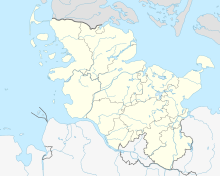Norderheverkoog
Coordinates: 54 ° 24 ′ 9 ″ N , 8 ° 47 ′ 30 ″ E
The Norderheverkoog belongs to the communities Tetenbüll and Osterhever on Eiderstedt ( North Friesland district ) in Schleswig-Holstein . There are currently around 150 buildings in the Koog .
history
The embankment of the Norderheverkoog was completed in 1937. The Koog was at its inauguration after the SA -man Horst Wessel named and carried his name until 1945. The Horst Wessel Koog was like, inaugurated in 1935, Adolf Hitler Koog a Musterkoog as part of the Nazi policy of blood and soil . The ideology of the National Socialists fell on fertile soil among the rural population. This was shown by the above-average election results for the NSDAP in the district of North Friesland .
The dike created an agriculturally usable area of 650 hectares and created 26 settler positions and seven agricultural workers positions.
As in the Adolf-Hitler-Koog, the settlers of the new Koog were strictly selected according to race criteria. The Horst-Wessel-Koog was not marketed in the media as a "peace achievement" by the National Socialists like the much more present and larger Adolf-Hitler-Koog. As in the Hermann-Göring-Koog, there was no assembly hall comparable to the Neulandhalle , which was used in the Adolf-Hitler-Koog for National Socialist training courses and to maintain the intensive National Socialist Koog community and was thus presented to the international guests.
The land gained was very small in the Kögen with a few 1000 hectares, but was ideally suited to illustrate the struggle for race and space in the sense of the National Socialist blood-and-soil ideology , since the new agricultural areas in the struggle with the " wild North Sea “had been wrested from the sea. The landscape on the west coast of Schleswig-Holstein was made to stage a combative "Nordic race". During the Second World War , interest in the Musterkoog quickly waned, as new settlement areas in the east could be won so much more easily as part of the military policy of conquest. The fall of the National Socialist state meant a deep turning point for the residents of the National Socialist model settlements. They lost the privileges of their model National Socialist settlements and their political home. Many settlers left the Koog.
economy
In addition to agriculture , tourism has established itself as a further economic pillar in the Norderheverkoog. Due to its location right on the coast, the Norderheverkoog is particularly popular with families.
Individual evidence
- ↑ a b c Lars Amenda: “People without space create space”. Racial policy and propaganda in the National Socialist land reclamation project on the west coast of Schleswig-Holstein. In: Information on Schleswig-Holstein Contemporary History (ISHZ). Edited by the working group for research into National Socialism in Schleswig-Holstein eV (AKENS), Kiel. Volume 45 (2005), DNB 017671612 , pp. 4–31 ( PDF; 228 kB ), accessed on December 28, 2008.

